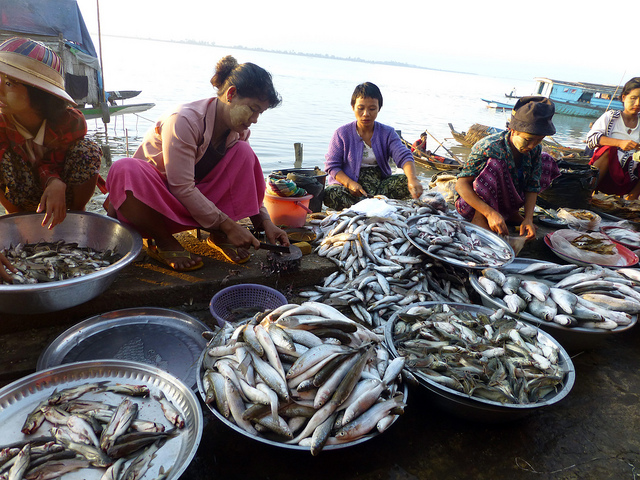
ဧရာဝတီ မြစ်ဝကျွန်းပေါ်ဒေသ ရှိ ဒေသခံ ငါးဈေးကွက်။ ဤပုံကို နိုဝင်ဘာလ ၂၇ ရက် ၂၀၁၂ ခုနှစ်တွင် Jharendu Pant, Flickr တို့မှ ရိုက်ယူထားပြီး CC BY-NC-ND 2.0 လိုင်စင်ဖြင့် မှတ်ပုံ တင်ထားပါသည်။
မြန်မာ့ရေထွက်ကုန် ကဏ္႑ သည် ပြီးခဲ့သည့် ငါးနှစ်အတွင်း စုစုပေါင်း ပြည်တွင်း ထုတ်ကုန်တွင် စတုထၳ အများဆုံး ပါဝင် ခဲ့သလို တိုင်းပြည်၏ နိုင်ငံခြား ဝင်ငွေ ရရှိသည့် စတုထၳ အကြီးဆုံး အရင်းအမြစ် ဖြစ်ခဲ့သည်။ မြန်မာနိုင်ငံရှိ အိမ်ထောင်စု အများစုသည် အဓိက မြစ်ကြီး လေးစင်းတစ်လျှောက်နှင့် မြစ်ဝကျွန်းပေါ်ဒေသများတွင် နေထိုင်လာ စဉ်ကတည်းက ကုန်းတွင်းပိုင်း ငါးဖမ်းလုပ်ငန်းမှ ရရှိသည့် ရေချိုငါးများသည် နေ့စဉ် အစားအစာ အတွက် သာ မဟုတ်ပဲ ကုန်သွယ်မူ့ အတွက် လည်း အဓိကဖြစ်ခဲ့သည်။ အိမ်ထောင်စုများသည် ယေဘုယျ အားဖြင့် ရေငန် ငါးများထက် ရေချိုငါး များ ကို ပိုမို ကြိုက်နှစ်သက် လေ့ရှိပြီး တစ်နိုင်ငံလုံး အတိုင်းအတာ နှင့် တစ်နှစ်ပတ်လုံး ယေဘူယျ ငါးနှင့် ငါးထုတ်ကုန်များ စားသုံး မူ့မှာ ၂၀၁၁ ခုနှစ်တွင် လူတစ်ဦး လျှင် ၅၅ ကီလို ဂရမ် ရှိကြောင်း သိရှိရသည်။ ၂၀၀၆ ခုနှစ် စားနပ်ရိက္ခာနှင့် စိုက်ပျိုးရေးအဖွဲ့အစည်း (FAO) ၏ စစ်တမ်းများ အရ ငါးသည် မြန်မာအိမ်ထောင်စုများ၏ အသားဓါတ် ဖြည့်တင်းမူ့တွင် ၂၂ ရာခိုင်နှုန်း ပါဝင် နေရာ ယူထား ပါသည်။1
ငါးထုတ်လုပ်ခြင်း
၂၀၁၃ ခုနှစ်တွင် ငါးနှင့် ဂဏန်း စုစုပေါင်း ထုတ်လုပ်မူမှာ တန်် သန််းပေါင်း ၄.၇ သန်း ရှိခဲ့ပြီး ၄၇ ရာခိုင်နှုန်းမှာ ရေချိုမှ ဖြစ်ပြီး ၅၃ ရာခိုင်နှုန်းမှာ ပင်လယ်ပြင် မှ ဖြစ်ကြောင်း သိရသည်။ ငါးလုပ်ငန်း ဦးစီးဌာနမှ စာရင်းများအရ မြန်မာ့ ငါးထုတ်လုပ်မူ့မှာ တိုးတက်လာခဲ့ပြီး ၂၀၁၂ ခုနှစ်တွင် တန် သန်းပေါင်း ၄၄၇၈.၂၁ သန်း ရှိရာမှ ၂၀၁၄ ခုနှစ်တွင် တန်သန်းပေါင်း ၅၀၄၇.၅၃ သို့ ရောက်ရှိလာခဲ့ကြောင်း သိရသည်။
ကုန်းတွင်း နှင့် အဏ္ဏဝါ ငါးဖမ်း လုပ်ငန်းမှ မြန်မာနိုင်ငံ ငါးထုတ်လုပ်မူ့၏ ၈၀ ရာခိုင်နှုန်း နီးပါး တန်ပေါင်း ၄.၁ သန်း ထုတ်လုပ်ပေးပြီး နိုင်ငံရဲ့ငါးထုတ်လုပ်မူ့တွင် အဓိက နေရာမှ ပါဝင်ခဲ့သည်။ ငါးမွေးမြူရေး လုပ်ငန်းမှာမူ ပြီးခဲ့သည့် ဆယ်စုနှစ် အတွင်း သိသာစွာ တိုးတက်လာခဲ့ပြီး ယခုအခါ နှစ်စဉ် ငါးထုတ်လုပ်မူ၏ ၂၂ ရာခိုင်နှုန်း သို့ ရောက်ရှိလာခဲ့ ရာ ၂၀၁၅ ခုနှစ်တွင် ၉၅၀ ၀၀၀ တန် ထုတ်လုပ်နိုင်ခဲ့ကြောင်း FAO မှ ထုတ်ပြန်ထားသော အစိုးရ စာရင်းဇယား များ အရ သိရသည်။2
ကမ္ဘာ့ စားနပ်ရိက္ခာနှင့် စိုက်ပျိုးရေးအဖွဲ့အစည်း (FAO) မှ ရရှိသော အချက်အလက်များအရ ၂၀၁၂ ခုနှစ် ကမ္ဘာ့ ငါးလုပ်ငန်း ထုတ်လုပ် မူ့မှာ တန်ပေါင်း ၁၅၈ သန်း ရှိခဲ့ပြီး အဏ္ဏဝါ ငါးဖမ်းခြင်း လုပ်ငန်းမှ တစ်ကမ္ဘာလုံး ငါးထုတ်လုပ် မူ့၏ ၅၀ ရာခိုင်နှုန်း တန်ပေါင်း (၇၉.၇) သန်း ရှိခဲ့သည်။ ကမ္ဘာ့ ငါးထုတ်လုပ်မူ့၏ ၇၆.၂ ရာခိုင်နှုန်းမှာ နိုင်ငံပေါင်း ၁၈ နိုင်ငံမှ ဖြစ်ပြီး အများဆုံး ထုတ်လုပ်သည့် နိုင်ငံမှာ တရုတ်နိုင်ငံဖြစ်သည်။3

စစ်တွေ ငါးဖမ်းဆိပ်ကမ်း။ ဤပုံကို မတ်လ ၁၅ ရက် ၂၀၁၂ ခုနှစ်တွင် dany13, Flickr တို့မှ ရိုက်ယူထာပြီး CC BY 2.0. လိုင်စင်ဖြင့် မှတ်ပုံ တင်ထားပါသည်။
မြန်မာနိုင်ငံသည် ၂၀၁၂ ခုနှစ်တွင် အဏ္ဏဝါ ငါးဖမ်းလုပ်ငန်းတွင် အမြင့်ဆုံး ၁၀ နိုင်ငံ ဖြစ်ပြီး ၂၀၀၃ ခုနှစ်မှ ၂၀၁၂ ခုနှစ် အတွင်း အဏ္ဏဝါ ငါးဖမ်းလုပ်ငန်းမှာ ၁၂၁ ရာခိုင်နှုန်း တိုးတက်ခဲ့သည်။ အဆိုပါ တိုးတက်မူ့သည် အဓိက ငါးထုတ်လုပ်သည့် နိုင်ငံ ၁၈ နိုင်ငံ အတွင်းတွင် အမြင့်ဆုံး ဖြစ်ခဲ့သည်။4
အဏ္ဏဝါ ငါးဖမ်းခြင်းလုပ်ငန်း အား အဓိကလုပ်ကိုင်သည့် နေရာများမှာ တနင်္သာရီ တိုင်းဒေသကြီး ရှိ မြိတ် မြို့နယ်နှင့် ရန််ကုန်တိုင်း တို့ဖြစ်ပြီး အဆိုပါ ဒေသများမှာ အဏ္ဏဝါ ငါးဖမ်းခြင်းလုပ်ငန်း ၏ အဓိက ထုတ်လုပ်ခြင်းနှင့် ဈေးကွက် အချက်အခြာ နေရာများ ဖြစ်သည်။5
စီးပွားရေးနှင့် ကူးသန်းရောင်းဝယ်ရေး ဝန်ကြီးဌာန၏ အဆိုအရ ၂၀၁၂-၂၀၁၃ ခုနှစ်အတွင်း မြိတ်နှင့် ထိုင်းနိုင်ငံကြား နယ်စပ်ကုန်သွယ်မူ့မှာ အမေရိကန်် ဒေါ်လာ ၁၂၅ သန်း ရှိခဲ့ပြီး ပင်လယ်စာ သည် အဓိက ပို့ကုန်များထဲမှ ထုတ်ကုန် တစ်ခု ဖြစ်သည်။ ခန့်မှန်းခြေအားဖြင့် ၂၀၁၃ ခုနှစ်အတွင်း မြိတ် ရှိ စုစု ပေါင်း ငါးထုတ်လုပ်မူ့၏ ၇၀ ရာခိုင်နှုန်းမှ ၇၅ ရာခိုင်နှုန်းအထိ အား ထိုင်းနိုင်ငံ နယ်စပ်သို့ ရောင်းချခဲ့ကြောင်း သိရသည်။6
ပို့ကုန် ဈေးကွက်
၂၀၁၃ ခုနှစ်တွင် မြန်မာနိုင်ငံမှ ငါးနှင့် ငါးထုတ်ကုန်များအား နိုင်ငံပေါင်း ၃၂ နိုင်ငံသို့ တန် သန်းပေါင်း ၃၄၅ ၀၀၀ တင်ပို့ခဲ့ပြီး အမေရိကန် ဒေါ်လာ ၅၃၆.၂၇ သန်း ရရှိခဲ့သည်။ ၂၀၁၃ ခုနှစ် စုစုပေါင်း ငါးထုတ်လုပ်မူ့၏ ၇ ရာခိုင်နှုန်းအား ပြည်ပသို့ တင်ပို့ ခဲ့သည်။ မြန်မာနိုင်ငံ၏ ဒေသတွင်း ဈေးကွက် အတွက် ပြည်ပပို့ကုန် အရောင်း အများစုမှာ နယ်စပ်ကုန်သွယ်ရေးမှ ရရှိပါသည်။7
တရုတ်နိုင်ငံသည် မြန်မာ့ငါး တင်ပို့မူ့တွင် အများဆုံး ဝယ်ယူသူ ဖြစ်ပြီး မြန်မာနိုင်ငံမှ တရုတ်နိုင်ငံသို့ တင်ပို့မူ့မှာ ၂၀၀၉ ခုနှစ် မှ ၂၀၁၃ ခုနှစ်အတွင်းတွင် ၄၈ ရာခိုင်နှုန်း မြင့်တက်ခဲ့သည်။
၂၀၀၉ ခုနှစ်တွင် ဥရောပ သမဂ္ဂမ မြန်မာ ပင်လယ်စာ တင်သွင်းမူ့ အားလုံးကို ပိတ်ပင်ခဲ့သည်။ မွေးမြူရေး ထုတ်ကုန်များ အား ဆက်လက်ပတ်ပင်ထားဆဲ ဖြစ်သော်လည်း ၂၀၁၀ ခုနှစ်တွင် ပင်လယ်စာ တင်သွင်းမူ့များအား ပြန်လည် ဖွင့်ပေးခဲ့သည်။ မြန်မာနိုင်ငံမှ ဥရောပ သမဂ္ဂ သို့ တင်ပို့မူ့မှာ တိုးတက်လာခဲ့ပြီး ၂၀၁၃ ခုနှစ်တွင် ယူရို ၂၂၃ သန်း ရှိရာ ရေထွက် ကုန်များမှာ ၈ ရာခိုင်နှုန်း ရှိခဲ့သည်။8
References
- 1. https://data.pp.opendevelopmentmekong.net/dataset/the-state-of-world-fisheries-and-aquaculture-2016
- 2. World Fish; Myanmar: http://www.worldfishcenter.org/country-pages/myanmar
- 3. FAO fishery country profile: the Union of Myanmar https://data.pp.opendevelopmentmekong.net/library_record/fao-fishery-country-profile-the-union-of-myanmar
- 4. Marine Capture Fisheries: http://www.ilo.org/wcmsp5/groups/public/—ed_emp/—emp_ent/documents/publication/wcms_446510.pdf
- 5. Marine Capture Fisheries: http://www.ilo.org/wcmsp5/groups/public/—ed_emp/—emp_ent/documents/publication/wcms_446510.pdf
- 6. Marine Capture Fisheries: http://www.ilo.org/wcmsp5/groups/public/—ed_emp/—emp_ent/documents/publication/wcms_446510.pdf
- 7. Bagan Trade Blog: http://blog.bagantrade.com/myanmar-fisheries-and-aquaculture-export-in-the-21st-century/
- 8. FAO fishery country profile: the Union of Myanmar https://data.pp.opendevelopmentmekong.net/library_record/fao-fishery-country-profile-the-union-of-myanmar

